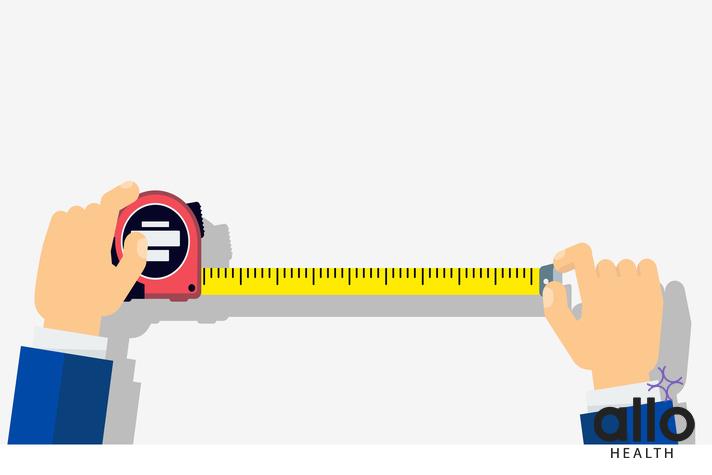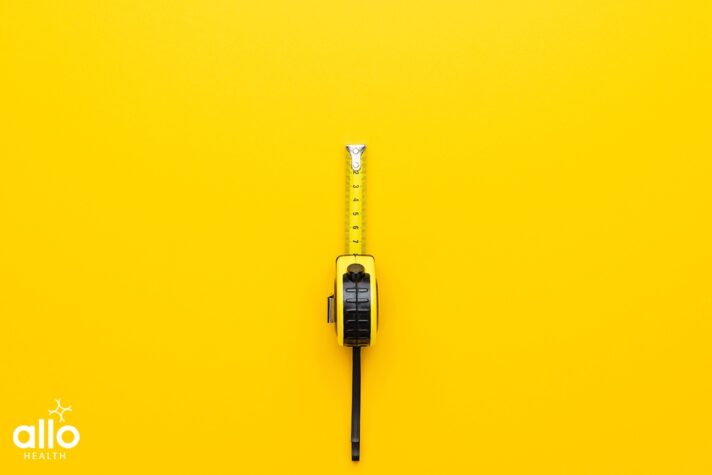What is the Average Penis Size for 13-Year-Olds?

Allo Health is dedicated to personalized well-being, offering support and trusted information tailored to individual health goals. The platform emphasizes human-generated content, led by a distinguished medical team of experts, including physicians and sexual health specialists. Their commitment to credibility involves rigorous fact-checking, authoritative research, and continuous updates to ensure accurate, up-to-date information. Allo Health's unique approach goes beyond conventional platforms, providing expert-led insights and a continuous commitment to excellence, with user feedback playing a crucial role in shaping the platform's authoritative voice.

Dr. Warisha holds an MBBS degree from GMERS Medical College, Ahmedabad. She has an in depth experience on sexual and reproductive health and rights.
Why This Was Upated?
Our experts continually monitor the health and wellness space, and we update our articles when new information became available.
Updated on 03 July, 2024
- Article was updated as part of our commitment to diversity, equity, and inclusion.

"The following blog article provides general information and insights on various topics. However, it is important to note that the information presented is not intended as professional advice in any specific field or area. The content of this blog is for general educational and informational purposes only.
Book consultation
The content should not be interpreted as endorsement, recommendation, or guarantee of any product, service, or information mentioned. Readers are solely responsible for the decisions and actions they take based on the information provided in this blog. It is essential to exercise individual judgment, critical thinking, and personal responsibility when applying or implementing any information or suggestions discussed in the blog."
As adolescents undergo the transformative journey of puberty, questions about physical changes become more common. One of the frequently asked questions pertains to the average penis size for 13-year-olds.
Puberty and Genital Development
Adolescence is a transformative experience marked by significant physical changes. For teens, one aspect that often becomes a focal point of curiosity and concern is penis size. It’s important to reassure both teenagers and their parents that penis size is rarely an indicator of a medical problem. However, the emotional rollercoaster of adolescence can make it challenging to accept this fact.
Between the ages of 10 and 14, a period characterised by rapid growth spurts, teenagers may find themselves comparing their development to that of their peers. This natural inclination to measure up can lead to feelings of inadequacy if they perceive themselves as anything less than average. Parents play a crucial role in dispelling these fears by sharing accurate information about normal penis development with their children.
Stages of Development
Understanding the stages of genital development can provide clarity and reassurance during this period of change. Sexual maturation in individuals with penises follows a somewhat predictable sequence:
- Onset of Puberty (9.5 to 14 years): The journey begins with the onset of puberty, a period when various changes take place in the body.
- First Pubertal Change: A notable milestone in puberty, the enlargement of the testicles marks the beginning of physical transformations.
- Penis Growth (Approximately one year after testicle maturation): Following the initial changes, penis growth occurs. It’s important to note that there is no specific age at which this will happen, making it a unique experience for each individual.
- Appearance of Pubic Hair (13.5 years): Another visible sign of puberty is the development of pubic hair.
- Nocturnal Emissions (‘Wet Dreams’) (Around 14 years): Wet dreams are a natural part of adolescent development and typically occur around the age of 14.
- Other Changes (Facial Hair, Deeper Voice, Acne) (Around 15 years): Additional changes, such as the deepening of the voice, the emergence of facial hair, and the onset of acne, usually occur around the age of 15.
It’s crucial to emphasize that, unlike some other pubertal changes, there isn’t a specific age at which genital growth begins. The process can vary widely among individuals, with some experiencing a gradual progression and others encountering more sporadic development.
Parents may wonder when to seek professional advice from health care professional if their child’s penis appears small even after the onset of other pubertal changes. There’s still an opportunity for growth after the age of 14. However, if concerns persist, scheduling an appointment with the family doctor can provide valuable insights and guidance.

When Does Penis Size Stop Growing?
- During puberty, the penis undergoes a remarkable period of growth. This growth is a natural part of the maturation process, and the timing varies from person to person.
- There is no specific age at which penis growth begins, mirroring the lack of a precise endpoint.
- As puberty progresses, the penis continues to develop.
- As puberty nears its end, the rate of penis growth gradually decreases until it stops. This signals the conclusion of a period marked by notable changes in the body.
- The age at which penis growth stops is not universally established.
- Although there is no one-size-fits-all answer, it’s common for little additional growth to be expected by the age of 18 to 19. This age range provides a benchmark, suggesting that the majority of individuals will experience a stabilization in penis size around this time.
What is the Average Penis Size for 13-Year-Old?
As outlined in Adolescent and Young Adult Health Care: A Practical Guide by Lawrence Neinstein, MD, the average penis length at the age of 13 is measured to be around 2.0 to 4.7 inches. It’s essential to keep in mind that this number should only serve as a guideline for genital development.
You can read to know about the average Indian penis size here.
Factors Affecting Penis Size
Several factors can influence penis size. It’s important to note that these factors interact in complex ways, and the interplay of genetics and hormonal influences plays a significant role. Some factors that may affect penis size:
- Genetics: The primary determinant of penis size is genetic. The traits inherited from parents, including those related to physical development, can influence the size of the penis.
- Hormonal Factors: Hormones, particularly testosterone, play a crucial role in the development of male reproductive organs, including the penis. Hormonal imbalances during puberty can affect growth.
- Puberty Timing: The timing of puberty varies among individuals. Those who experience puberty later may continue to see growth in their reproductive organs for a longer period.
- Nutrition: Adequate nutrition is essential for overall growth and development, including the development of reproductive organs. Malnutrition during crucial growth periods can impact size.
- Health Conditions: Certain health conditions, especially those affecting hormone levels or blood flow, can influence penis size. Conditions like hormonal disorders or vascular issues may have an impact.
- Environmental Factors: Environmental factors, such as exposure to endocrine-disrupting chemicals or toxins, could potentially affect hormonal balance and development.
- Weight: There may be a correlation between body weight and penis size. In some cases, excess weight can make the penis appear smaller due to the presence of a fat pad around the base.
- Age: The penis undergoes growth during puberty, and growth may continue into late adolescence. However, after a certain age, growth is unlikely.
- Race and Ethnicity: It is suggested that there may be variations in average penis size among different ethnic groups. However, these differences are generally within a normal range.
Does Size Matter?
- The significance of penile size is a subjective matter and can vary among individuals.
- It’s important to recognize that there is a wide range of sizes considered normal, and what matters most is how an individual feels about their own body and their overall well-being.
- From a medical standpoint, having a smaller or larger penis doesn’t necessarily indicate a health problem.
- Sexual function, overall health, and the quality of relationships are far more crucial factors for a fulfilling and satisfying sexual experience.
- In many cases, concerns about penis size may be driven by societal expectations or misconceptions perpetuated by media.
- It’s essential to promote a healthy understanding of body diversity and to emphasize that there is no one-size-fits-all standard for genitalia.
When Should Penile Size Be a Concern?
Penile size is generally not a cause for concern from a medical perspective. However, there are situations where individuals may experience anxiety or distress related to their perception of penile size. In such cases, it may be appropriate to seek guidance or professional support. Here are some situations where concerns about penile size might be addressed:
- Persistent Distress: If an individual is consistently distressed or anxious about the size of their penis to the extent that it affects their mental well-being, self-esteem, or relationships, it may be helpful to consult with a mental health professional.
- Physical Health Issues: If there are physical symptoms or conditions affecting the genital area, such as pain, discomfort, it’s important to seek medical advice. These issues are more relevant to overall health than the size of the penis.
- Body Dysmorphic Disorder (BDD): In some cases, extreme concerns about physical appearance, including the size of body parts, may be indicative of body dysmorphic disorder. If such concerns are causing significant distress, a mental health professional can provide support.
- Puberty and Development: During puberty, individuals may experience a range of emotions related to the changes happening in their bodies. It’s essential for parents, caregivers, or educators to provide accurate information and emotional support during this period.
- Sexual Function: Micropenis may impact sexual function and satisfaction. Open communication with a healthcare provider or a sexual health specialist can help address any challenges and explore potential solutions.

Diagnosis of Micropenis
Micropenis is a medical condition where the penis is smaller than usual. Doctors measure this by comparing its length to what’s typical for a person’s age. If it’s much smaller, around 2.5 times less than what’s average, it’s considered micropenis. This condition is uncommon but is identified by a significant deviation from the expected size based on age.
Treatment:
Treatment for micropenis depends on the underlying cause and may vary for each individual. Some potential treatment options:
- Hormone Therapy: If micropenis is associated with hormonal deficiencies, hormone replacement therapy (HRT) may be recommended. This involves the administration of hormones, such as testosterone, to promote normal growth and development.
- Growth Hormone Therapy: In some cases, growth hormone therapy may be considered to stimulate overall growth, including penile growth.
- Surgery: Surgical interventions may be explored in certain cases. Procedures such as phalloplasty aim to increase the length or girth of the penis. However, these surgeries are typically reserved for severe cases and are not without risks.
- Psychological Support: Given the potential psychological impact of micropenis, counseling and therapy may be beneficial. Mental health professionals can provide support to individuals dealing with body image concerns and help manage any emotional distress.
- Educational Support: For adolescents, providing accurate information about micropenis, its causes, and available treatments is crucial. Educational initiatives can help reduce stigma and create a more understanding environment.
It is important to note that not everyone with a smaller-than-average penis requires or chooses treatment. The decision to pursue intervention is often influenced by individual factors, including the presence of associated medical conditions, psychological well-being, and personal preferences.
A qualified health provider can help you come to the best decision.
Key Takeaways
- Adolescence brings questions about penis size, a common concern during puberty.
- Puberty’s rapid growth from ages 10 to 14 sparks self-comparisons and anxiety.
- Genital development stages include puberty onset, testicle enlargement, and varied penis growth timing.
- Penis growth continues through puberty, slowing by ages 18 to 19.
- Average size of penis by length at 13 is 2.0 to 4.7 inches, a guideline for development.
- Factors affecting size include genetics, hormones, nutrition, and overall health, with mental well-being emphasized.
Frequently Asked Questions
Q. Will my penis size change as I continue to grow?
A. Penis growth typically continues throughout puberty and even into early adulthood. Hormonal changes, specifically increased testosterone production, contribute to this growth. If you have concerns about your development or other aspects of puberty, it’s a good idea to discuss them with a trusted healthcare professional who can provide accurate guidance and reassurance.
Q: Is there a “normal” or ideal penile size for teenagers, and what factors contribute to the natural variation?
A: There is a wide range of sizes considered normal. Genetics, hormonal influences, and individual development timelines contribute to the natural variation in penile size during adolescence.
Q: Should teenagers compare themselves to peers in terms of penile size, and how can they navigate potential insecurities?
A: Comparisons can lead to unnecessary anxiety. Emphasize that individual growth rates vary, and reassurance from parents or guardians can help navigate potential insecurities.
Q: Can masturbation or sexual activity impact penis length during adolescence, and is there any truth to common myths surrounding these activities?
A: Masturbation and sexual activity do not have a significant impact on penile length. Debunking myths can provide accurate information and alleviate concerns.











































